midweek gems #30
culinary DEI + finding everyday beauty in the kitchen + longevity strategies + pho workarounds
Diversity, equity, and inclusion are not popular terms in board rooms right now but when it comes to food and cooking, you’re here because you’re interested in at least one of those concepts. There are people who can happily eat the same food for their entire lives, but you and I are not those people.
That’s why PTFS exists — to help you explore new flavors and techniques to enrich our culinary lives and hopefully improve our well-being for the long run. I want to keep eating the food I like until the moment I die! Today’s Midweek Gems touches on broadening our understandings of culture, health, and cooking.
💎 AAPI recognition by BAMCO
Something really nice happened this month that I hesitated to share with you because of the political climate that we’re in. But screw it. Here it is . . .
Bon Appetit Management Company (BAMCO) featured me for the entire month of May, as part of Asian Pacific American Heritage Month (APAHM). The company manages over 1,000 cafes all over the nation at corporations, universities, museums, and event spaces. They have long been committed to healthful eating and sustainable food production. As part of its 2025 AAPHM celebration, BAMCO spotlighted my career and recipes in a series of articles for its wide-ranging audience.
Recipe Sneak Peek from Ever-Green Vietnamese (take EGV’s spicy mushroom and lemongrass stir-fry for a spin!)
And, some of BAMCO’s cafes cooked dishes from Ever-Green Vietnamese too!
BAMCO’s acknowledgment means a lot during these times when diversity seems to officially matter less. We have more in common in the kitchen and at the table than we know. We just need opportunities to discuss those commonalities.
💎 Finding everyday beauty in the kitchen
If we cook a lot, we must prep and clean. A lot. The day-to-day cooking process can easily become tedious so I try to find beauty in little things — the shape of herb leaves is Nature’s artistry at work. The sound deep frying resembles a gentle rainfall.
I normally let ingredients or the active process of cooking dictate everyday beauty in the kitchen. Recently, I unexpectedly experienced everyday beauty in a more prosaic item.
If you’ve ever been to an Asian market, houseware shop, or restaurant supply store, you may have noticed the incredible range of colanders, strainers and bowls on sale. We’re into them — from big to tiny, made of plastic, bamboo, or metal. (Let’s call them all colanders to make things easy from here on in.)
Even with all those options, good colanders are hard to find.
But what makes a good colander? What are your thoughts on this important everyday kitchen tool?
For me, a workhorse colander is designed with holes all over so food will drain quickly and thoroughly. No water pools or hangs out at the bottom to hide moisture. You’ll find no cutie colander with patterns of stars, flowers, circles or the like in my kitchen. I’m into fast and efficient drainage. Give me lots and lots of drainage holes.
And if the strainer has a matching bowl to fit, even better! For many years, I relied on matching sets of sturdy plastic strainers and bowls sold at Asian restaurant supply shops like Kamei in San Francisco.
Back in February, as a 2025 birthday gift to myself, I upgraded to a stainless steel set of nesting bowls and strainers by Sori Yanagi (1915-2011), a Japanese designer of simple, beautiful, and useful things. Considered the father of modern Japanese design, he also designed the 1972 Winter Olympic torch for the games in Sapporo, Japan.
The Yanagi bowls and colanders were expensive ($85 for the set) but shipped for free from Japan via Amazon Prime. I’d been using the same yellow, orange and pink plastic strainers for decades. Didn’t I deserve something better after my 2020 kitchen remodel? Or were they just a pricey splurge I’d regret, like the long forgotten Italian stilettos in my closet?
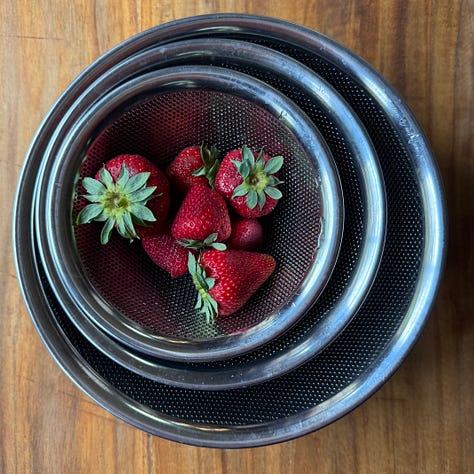
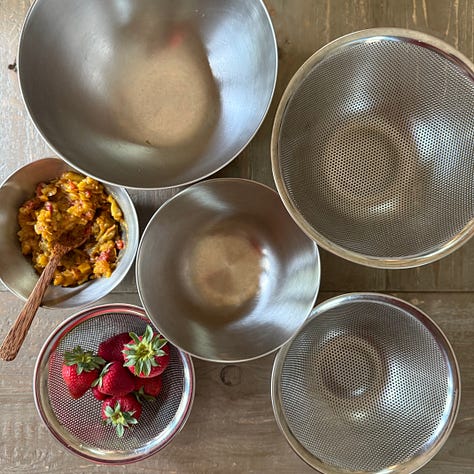
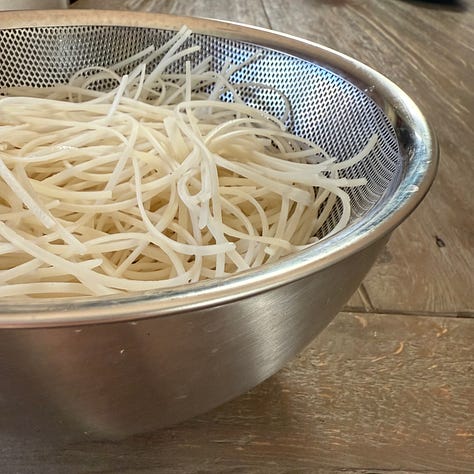
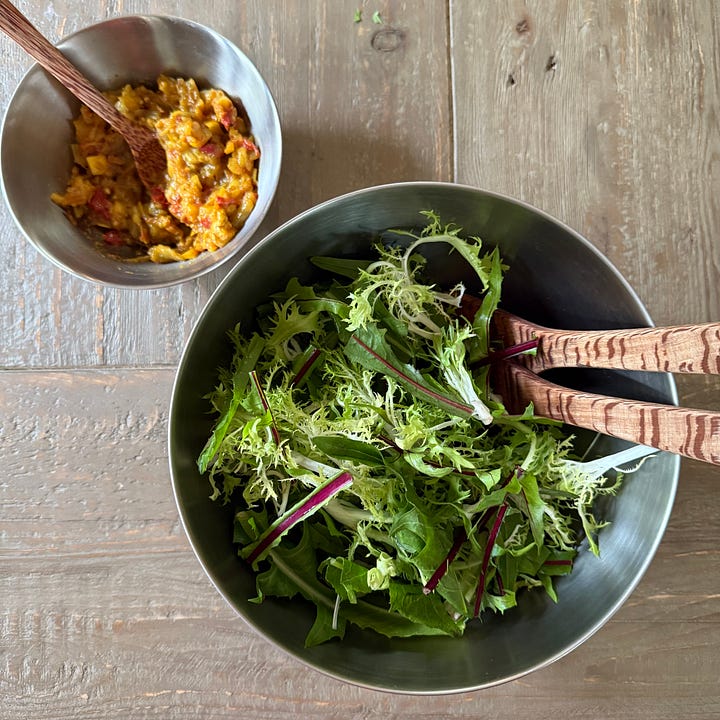
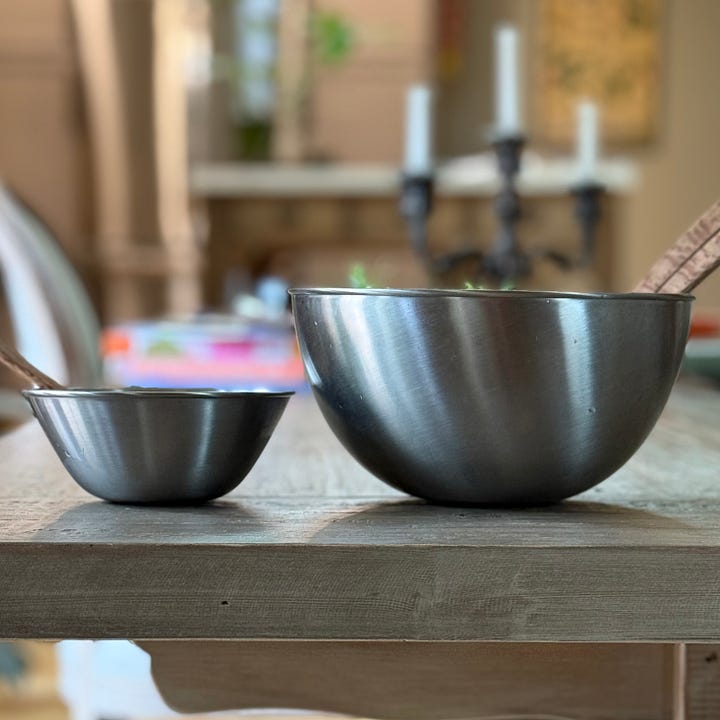
I took the plunge and surprisingly have been incredibly happy with the set. They are super compact, all six of them sit neatly stacked no higher than 4 1/2 inches (11.25cm) tall in a drawer with many other things.
The colanders, labeled “punching strainers”, drain incredibly well. In fact, because the holes are about 3/16 inch (5mm) wide, I’ve used it as a very coarse sieve, positioned on top of a bowl or pot. There’s a lip that allows them to hang out with little fuss. I can press on them firmly to expel excess water.
And the set has an interesting feature. Whereas the small and medium bowls and strainers match one another’s sloped sides, the largest bowl in the set has a round bottom and is much bigger than the colander. The result is you can toss and serve a salad in that big bowl. It looks chic and Danish modern-ish, but it’s Japanese!
I thought I was the only one happy with the set. But Rory recently told me how he loved using them too. He rarely says that about any kitchen tool. They’re light and easy and handsome.
Get a set or just browse all the Sori Yanagi stuff, if you’re into form and function and everyday beauty.
💎 3 hopeful stories
Tired of hearing about dementia, obesity and diabetes? It’s serious stuff but I’d love some happy news that inspires me to maintain a healthy lifespan (‘lifespan’ is the newish term in the longevity industry).
Two Wall Street Journal stories to give us all hope and strategies as we age:
Americans in their 80s and 90s Are Redefining Old Age (forget the boomers — we’re talking about people my mom’s age living their best lives!)
A Doctor’s Science-Backed Formula for Aging Better (some very simple tips for leading healthy lives from La Jolla-based cardiologist and researcher, Eric Topol)
And, because we’re closing up AAPHM and May is when people think a little extra about Mexican heritage because of Cinco de Mayo, this LA times story on transpacific bonds is worth a read!
These three stories are gift links so they’ll expire at some point. Read them soon when you have a moment.
💎 Pho tips
Last week, I hankered for pho from my frozen pho bank but I was short on beef and I had no cilantro handy. So I boiled an egg with the noodles and added it to our bowls to make up for the meat. After all, raw egg is an optional add-in in Hanoi for beef pho. And, it’s common to add added boiled egg to chicken pho for extra protein and fun.
Without cilantro, I used Vietnamese coriander (rau ram) from the garden, where I plucked some mint too. There was Thai basil hanging around too. I also made a batch of garlic vinegar for a Hanoi touch. Pho is open to a certain amount of freestyle cooking. Try it out with the Beef Short Rib and Vegetable Pho recipe.
Cooking Thai is due to our publisher very soon. Wish me luck. For this coming Sunday, I’ll be sharing a recipe requested by a new paid subscriber. Join us, if you have not!


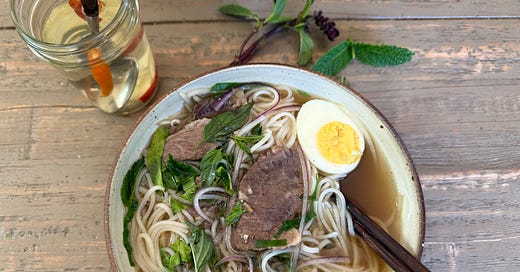


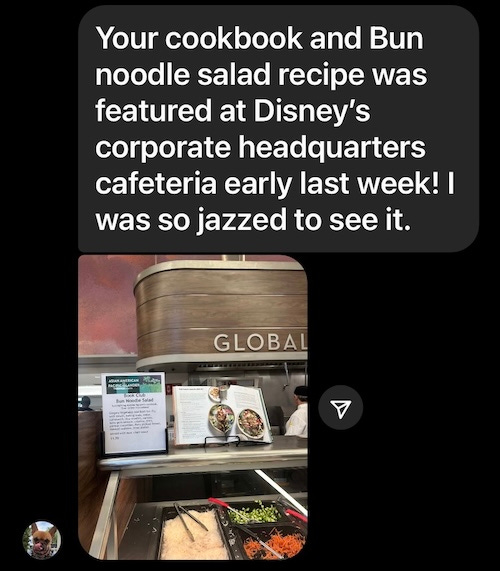

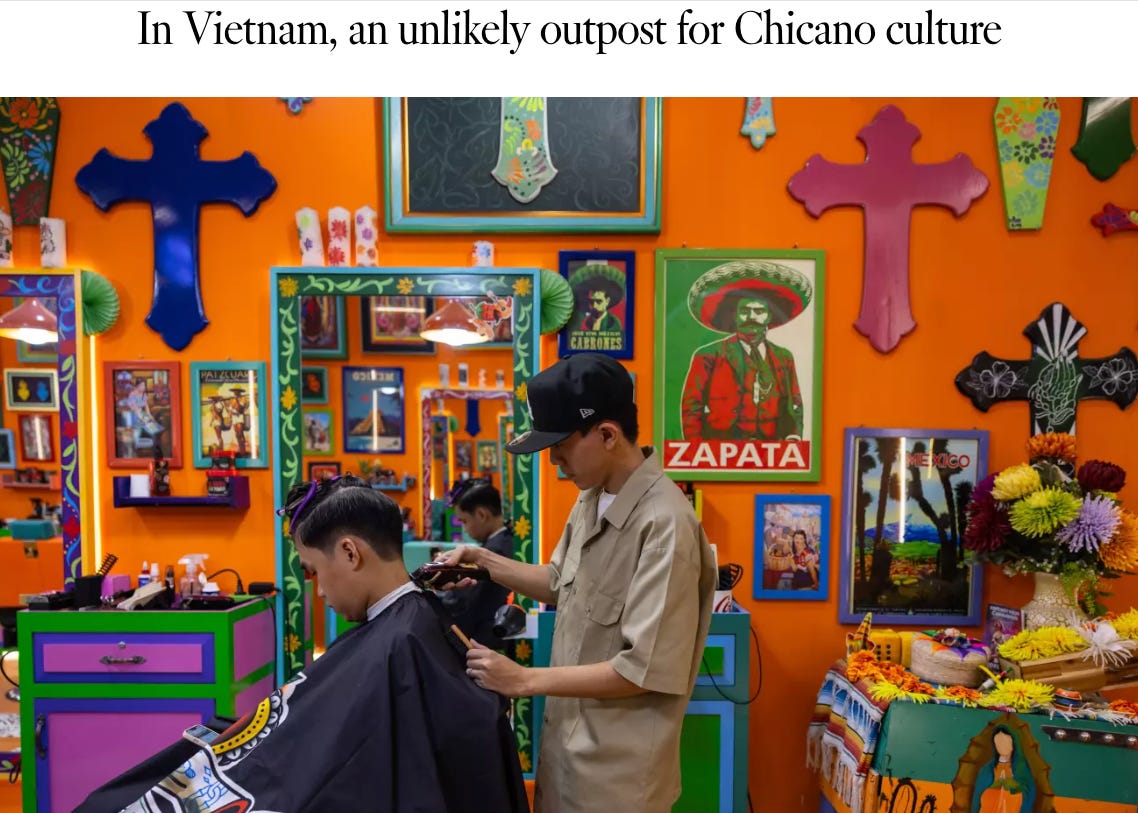


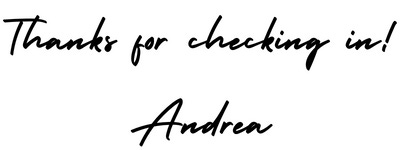
I have two. A generic big metal sieve with one long handle and a mesh of tiny holes. The other one is more interesting. It's a plastic thing, once yellow, I guess. My mother didn't use it and she gave it to me when I left home, age seventeen. It has travelled with me from student room to student room, from room to house and from country to country. I still use it a lot. At the bottom it has holes, above a round foot(?), so the leaked water doesn't touch what's inside the colander. What makes it super efficient is that all around there are many narrow vertical slits from top to bottom, which are very useful if you want to dry a lot. The thing has a late Fifties/early Sixties vibe to it.
What a powerful opening paragraph, Andrea — Culinary DEI.
Wishing you all the luck on Cooking Thai!